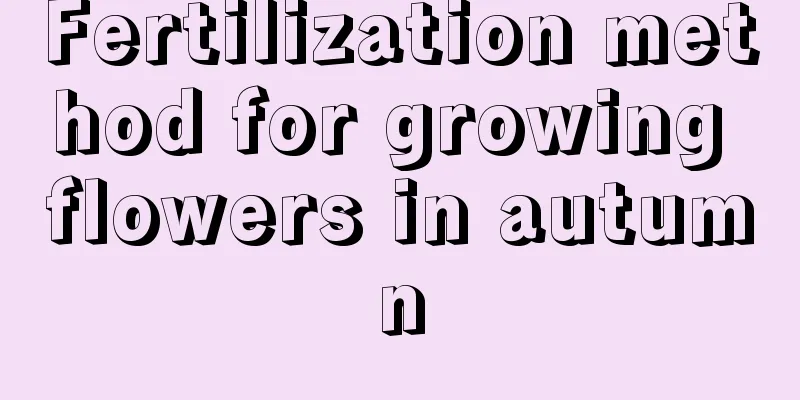Fertilization method for growing flowers in autumn

Tips for fertilizing flowers in autumnFertilization tipsWhen growing flowers, you need to fertilize them appropriately, and the same applies to autumn fertilization, which should be done according to the growth needs of the flowers. Autumn is the second growth season for some plants and the flowering season for some plants. It is also the season when the growth of some plants slows down. Fertilization must be based on specific circumstances. For plants that are in the growth period, what needs to be done is to promote plant growth and replenish soil nutrients through fertilization; for plants that bloom in autumn, it is necessary to promote flowering and make the flowers bloom brightly, so more fertilizers that promote flowering can be applied; for plants that are already in a period of slow growth, it is time to start reducing fertilization. Fertilization cycleWhen fertilizing flowers, you must control the amount of fertilizer and apply fertilizer according to a certain cycle. According to the principle of applying fertilizer thinly and frequently, the amount of fertilizer applied each time should be small, but you can apply it more times. In early autumn, when the plants are still growing, you can apply fertilizer every 7 to 10 days. As autumn progresses, the temperature drops and the growth of plants slows down, so you need to apply fertilizer every 15 to 20 days and slowly stop fertilizing. Fertilizer selectionFertilizers need to be selected according to the needs of the plants. Plants that bloom in autumn need to make their flowers bloom beautifully, so they need to add some phosphorus fertilizer and potassium fertilizer; plants that continue to grow in autumn need to supplement nutrients, apply some dilute fertilizer water, or some well-rotted farmyard manure, and some nitrogen fertilizer can also be applied, such as some foliage plants, but plants that hibernate in winter must reduce the application of nitrogen fertilizer. Notes on fertilization in autumnGrowth habits of flowersDifferent plants have different growth habits. Although fertilizer application is reduced in autumn due to the cooler weather, specific fertilization operations should still be carried out according to the growth habits of flowers. Whether flowers are in the growing period, flowering period or dormant period in autumn determines how often they should be fertilized and what kind of fertilizers should be applied. Flower characteristicsDifferent types of plants require different fertilizers. Plants that like acid should avoid alkaline fertilizers. Instead, you can apply some superphosphate and other fertilizers. For foliage plants, you can apply more nitrogen fertilizers. For bulbous plants and aromatic plants, you can apply some phosphorus fertilizers, potassium fertilizers and other fertilizers. |
<<: In autumn, when the temperature drops, key points for bringing potted flowers indoors
>>: Tips on fertilizing flowers in autumn
Recommend
What flowers are suitable for growing in Suzhou? What are the city flowers and trees?
1. Climate characteristics of Suzhou Suzhou has a...
When does the cinnabar root bloom?
1. Flowering period Cinnabar root will bloom, the...
The role and value of chicory
Medicinal Value of Chicory Chicory can be used fo...
The efficacy and function of loofah flowers
1. It can clear away heat and detoxify The flower...
Top 10 Indoor Ornamental Plants
Generally speaking, most plants suitable for indo...
These 10 kinds of climbing flowers bloom for 300 days. You’ll be addicted after planting them once!
Lonza Gemstone Longsha Gem is the "Internet ...
Digitalis cultivation methods and precautions
Distribution of Digitalis The origin of digitalis...
How to prune jade trees to make them look good
After pruning the jade plant, you should water it...
What to use to disinfect the rotten roots of the fortune tree? What to do if it rots and stinks
1. What to use for disinfection If the stem is al...
The difference between lotus and pennywort
1. Different plant types Nasturtium is also known...
One of her flowerpots is worth more than your yard
Pansy, horned pansy, primrose, ivy, etc. Cosmos, ...
How to grow purple basil
1. Site selection When planting purple basil, you...
How to make brocade out of red silk
1. Plenty of sunlight The leaves of the succulent...
Prevention and control methods of leaf blight in autumn
Prevention and control methods of leaf blight in ...
Soilless vegetable cultivation
1. Overview Soilless cultivation is a new technol...









